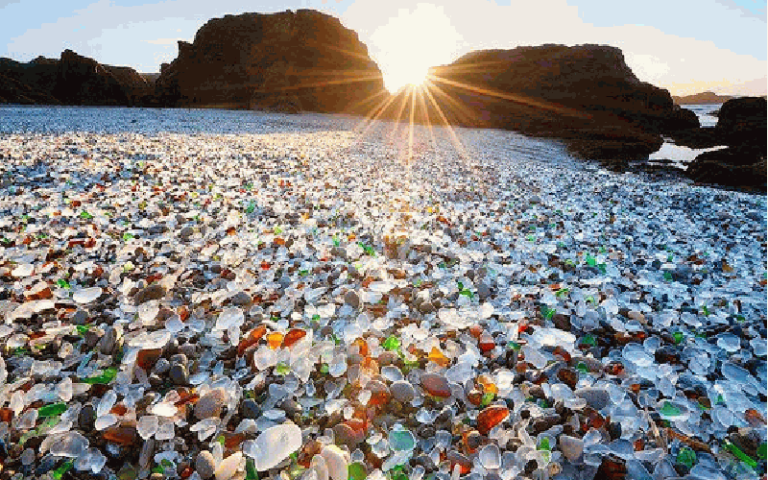How to Identify Carnival Glass
Carnival glass is a beautiful, iridescent glassware that was very popular in the early 1900s. Today, it is highly collectible and can be quite valuable. If you are interested in collecting carnival glass, it is important to know how to identify it.
Here are some tips: First, look at the color of the glass. Carnival glass is usually a bright, vivid color, such as blue or green.
It may also be purple or red. The colors are created by adding metal oxides to the glass during manufacturing. Next, examine the surface of the piece for an iridescent sheen.
This is caused by a thin layer of oil applied to the surface of the hot glass during production. The oil creates a rainbow-like effect when light shines on it. Finally, hold the piece to the light and look at its thickness.
Carnival glass is usually quite thin and delicate. If it is thick and heavy, it is probably not carnival glass.
- Look at the glass piece in natural light to check for a thin, iridescent film on the surface of the glass
- This is a telltale sign of carnival glass
- Hold the glass up to your eye and look at it from different angles
- Carnival glass will often have a “rainbow” effect when you do this
- Check for any areas on the surface of the glass that seems to reflect light differently than others
- Carnival glass will often have a “peacock” tail feathering effect, with certain areas of the glass reflecting light more brightly than others
- Feel the surface of the glass piece to see if it feels smooth or slightly rough
- Smooth surfaces are another hallmark of carnival glass
What is the Rarest Color Carnival Glass?
Carnival glass is a type of pressed glass that was first introduced in the early 1900s. It was originally made in a limited number of colors, but new colors were introduced over time. Today, carnival glass pieces are in a wide range of colors, from the traditional clear and blue to more unusual shades like pink and purple.
So, what is the rarest color of carnival glass? That’s a difficult question to answer definitively because it can depend on several factors, including the age of the piece and where it was made. However, some experts believe that the rarest carnival glass color is green.
Green carnival glass was produced in small quantities during the early years of production, making it hard to find today. If you’re lucky enough to come across a green piece of carnival glass, it’s sure to be a treasured addition to your collection!
What is the Most Sought After Carnival Glass?
Carnival glass is a beautiful, iridescent glass that was popular in the early 1900s. It was made by pressing molten glass into metal molds and spraying it with metallic salts. This gave the glass its characteristic rainbow-like sheen.
Carnival glass was produced in various colors, but the most sought-after colors are orange, green, and purple. These colors are often referred to as “fruit salad” carnival glass because they resemble the colors of fruit salads. Other popular colors include blue, red, and pink.
The most sought-after carnival glass pieces are those that the Northwood Glass Company made. Northwood was known for producing high-quality carnival glass with intricate designs. Pieces made by Northwood are highly collectible and can be worth thousands of dollars.
Is Vintage Carnival Glass Worth Anything?
Carnival glass is a pressed glass that was first made in the early 1900s. It gets its name because it was often given away as prizes at carnivals and fairs. Carnival glass is usually brightly colored, with an iridescent finish that makes it look like it has been sprayed with oil.
Over the years, carnival glass has become increasingly collectible, and some pieces can be quite valuable. However, not all carnival glass is worth a lot of money. The value of any particular piece depends on its age, condition, rarity, and desirability to collectors.
If you’re thinking about selling your carnival glass collection or are just curious about what it might be worth, your best bet is to consult an experienced appraiser or antique dealer. They will be able to give you a more accurate estimate of the value of your pieces than anything you’ll find online.
What is the Difference between Carnival Glass And Depression Glass?
Carnival and Depression glass are pressed glass, meaning they were made in molds. Carnival glass was first produced in the early 1900s and became popular in the 1920s. It was made with a process that gave it an iridescent sheen, similar to an oil slick.
The most common carnival glass colors are green, blue, and purple. Depression glass was produced during the Great Depression, from about 1925 to 1940. It was made in various colors, but the most common are pink and yellow.
Unlike carnival glass, which was mass-produced, Depression glass was often given away as premiums or as gifts with purchases.
Fake Carnival Glass
Carnival glass is a pressed glass that was first made in the early 1900s. It was originally produced in America but later became popular in Europe. The glass is usually brightly colored and has a glossy finish.
It is often decorated with patterns that resemble those found on carnival rides or games. Fake carnival glass is any piece of glass that is made to look like carnival glass but is not actually from the period. There are many reasons why someone might make fake carnival glass.
Some people do it for financial gain, while others enjoy the challenge of creating something that looks like the real thing. There are several ways to spot fake carnival glass. One of the most obvious is to look at the colors.
Carnival glass was typically made in very bright colors, so if a piece looks dull or muted, it’s probably not authentic. Another clue is to look at the patterns. Fake pieces often have patterns that are too perfect or too symmetrical.
Real carnival glass usually has imperfections and irregularities in the design. Of course, the best way to be sure you’re getting authentic carnival glass is to buy from a reputable dealer specializing in antique and vintage items. With some knowledge and care, you can add beautiful pieces of carnival glass to your collection!
Conclusion
Carnival glass is a type of pressed glass that was first made in the late 1800s. It gets its name from the carnival-like colors it is often found in, such as pink, blue, and purple. Carnival glass was originally made as a cheaper alternative to cut glass, but it has since become a collectible item in its own right.
There are a few things you can look for to help identify carnival glass: 1) The surface of carnival glass is usually dull, not shiny. 2) It often has an “iridescent” finish, which means it appears to change color when viewed from different angles.
3) Carnival glass was usually made in bright colors, so if you see a more subdued piece, it is less likely to be carnival glass. 4) Look for patterns on the surface of the glass. Carnival glass often has intricate designs etched into it.




